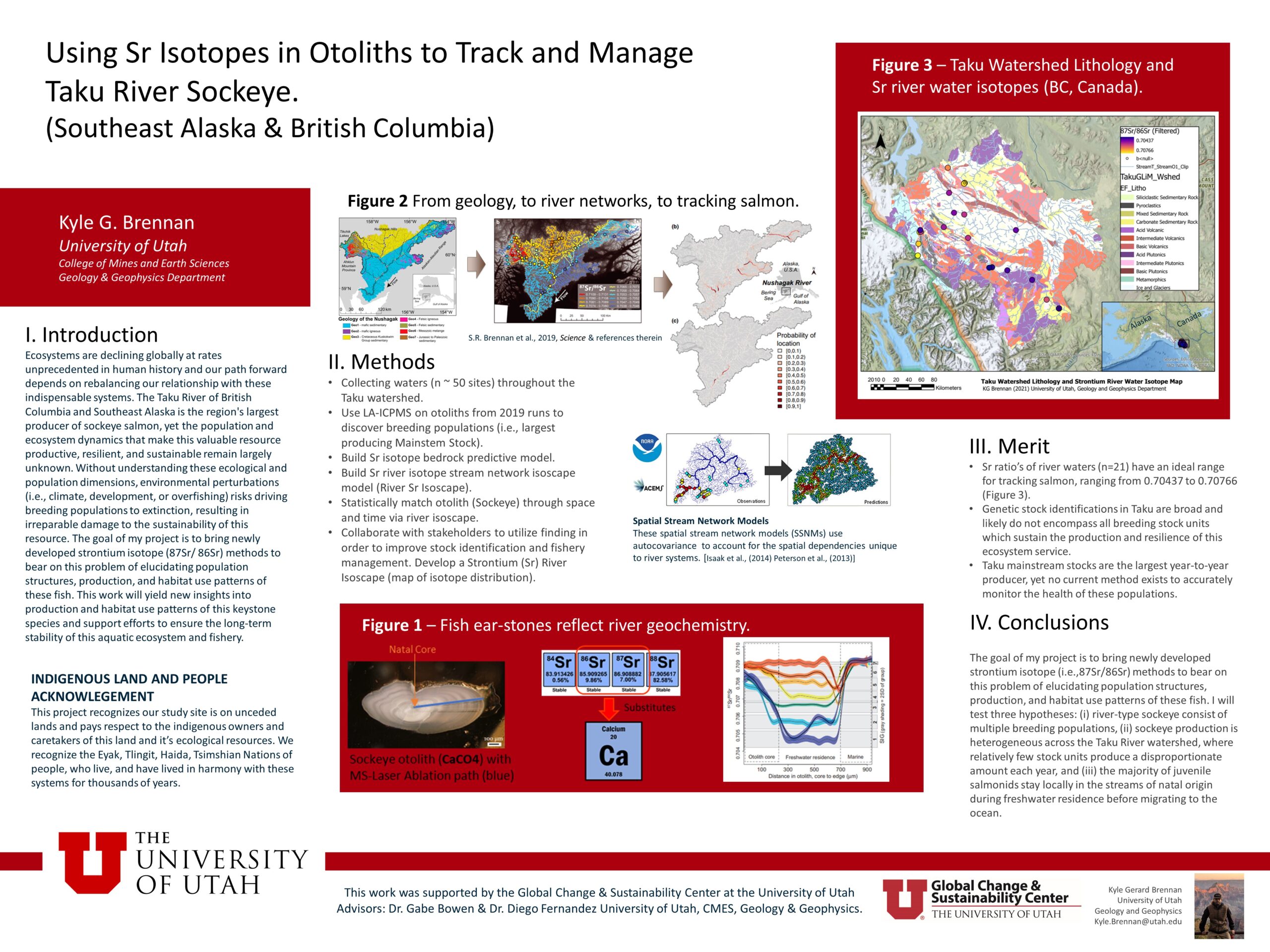Using Sr Isotopes in Otoliths to Determine Breeding Populations of Taku River Sockeye
–Kyle G. Brennan
[bs_collapse id=”collapse_bb86-afd7″]
[bs_citem title=”Bio” id=”citem_e610-6c22″ parent=”collapse_bb86-afd7″]
Kyle is currently a PhD candidate working with Gabe Bowen and Diego Fernandez of the Geology and Geophysics Department. Kyle Brennan is a Salt Lake City local. With the Wasatch mountains as his playground, he naturally gravitated towards studying Geoscience at the University of Utah where he earned his B.Sc. He then moved to Germany to receive his Masters in Geology at the Ludwig-Maximilians Universität München where his research focused on characterizing the geochemical remagnetization of the Northern Calcareous Alps. Now he is back and excited to join the SPATIAL team, where his work is focused on contributing powerful Sr isotope biogeochemical tools to understand, track, and manage the last productive wild salmon stocks of North America. He is also interested in building models to quantify how interactions between aquatic and terrestrial ecosystems affect (i) transport of organic carbon and inorganic nutrients in rivers, (ii) hydrological connectivity and evaporation across river basins, and (iii) controls on spatial variability in bioavailable contaminants across river basins due to anthropogenic activities.
[/bs_citem]
[bs_citem title=”Abstract” id=”citem_eca8-96a7″ parent=”collapse_bb86-afd7″]
Ecosystems are declining globally at rates unprecedented in human history and our path forward depends on rebalancing our relationship with these indispensable systems. The Taku River of British Columbia and Southeast Alaska is the region’s largest producer of sockeye salmon, yet the population and ecosystem dynamics that make this valuable resource productive, resilient, and sustainable remain largely unknown. Without understanding these ecological and population dimensions, environmental perturbations (i.e., climate, development, or overfishing) risks driving breeding populations to extinction, resulting in irreparable damage to the sustainability of this resource. The goal of my project is to bring newly developed strontium isotope (87Sr/ 86Sr) methods to bear on this problem of elucidating population structures, production, and habitat use patterns of these fish. This work will yield new insights into production and habitat use patterns of this keystone species and support efforts to ensure the long-term stability of this aquatic ecosystem and fishery.
[/bs_citem]
[bs_citem title=”Narrative” id=”citem_780c-0f71″ parent=”collapse_bb86-afd7″]
My project aims to use geochemical tracers (Strontium Isotopes) which are recorded in salmon ear stones to discover the different breeding populations of this important Taku River fishery. As river systems drain different bedrock geologies the river’s water isotope geochemistry also changes. As a salmon moves through the river network the changing water chemistry is reflected in the fish’s ear stones. By matching these ear stones to the river chemistry we can see where the fish were born and how they used the watershed before migrating to the ocean. Breeding populations as a whole represent the back bone of production for the entire fishery. If a hand full of population have low production years, they are compensated by others. Yet, if we can’t accurately track these populations we run the risk of driving them to extinction via overfishing, development, or climate change. Therefore, its important we invest and move towards new and accurate techniques that can be used to track and manage our ecological resources, so they can be sustained for future generations.
[/bs_citem]
[/bs_collapse]

